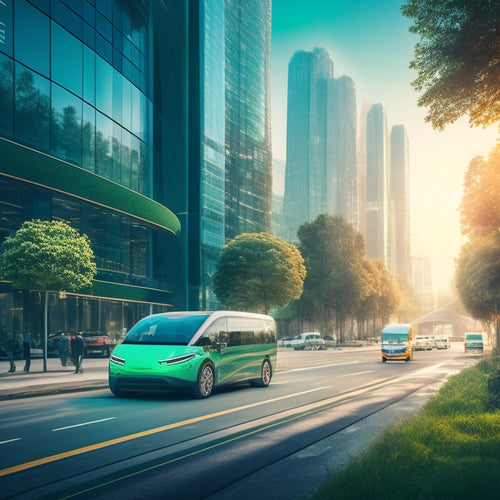
What's Next for Green City Logistics?
Share
You're on the cusp of a revolutionary shift in urban logistics, where electric vehicles, sustainable infrastructure, and innovative technologies converge to transform the face of Green City Logistics. Expect expanded EV infrastructure, green last-mile delivery hubs, and sustainable urban planning strategies to reduce emissions and operating costs. Alternative fuel options will rise, public transit will electrify, and personal EV adoption will increase. Autonomous delivery vehicle trials will pioneer safety standards, while green bond financing and city-wide e-mobility incentives will accelerate the shift. As you explore these developments, you'll uncover the blueprint for a cleaner, healthier, and more efficient urban environment - and that's just the beginning.
Key Takeaways
• Green City Logistics expands EV infrastructure, prioritizing range freedom and lower operating costs for a cleaner environment.
• Alternative fuel options and public transit electrification reduce carbon emissions and operating costs, driving a sustainable future.
• Autonomous delivery vehicle trials pioneer rigorous safety standards, collaborating with governments to establish clear regulatory frameworks.
• Smart traffic management systems optimize urban mobility, alleviating congestion and reducing emissions for a smoother urban flow.
• Green bond financing and city-wide e-mobility incentives accelerate EV adoption, promoting climate resilience and reducing carbon footprint.
Electric Vehicle Infrastructure Expansion
As Green City Logistics accelerates its mission to become carbon neutral, it's essential that you prioritize the expansion of electric vehicle (EV) infrastructure, ensuring a smooth shift for your fleet and supporting the growing demand for sustainable transportation.
As you scale up your EV fleet, it's important to address the pressing issue of energy storage. You'll need to invest in advanced energy storage systems that can efficiently manage the increased power demand. This will ensure a stable and reliable energy supply, minimizing the strain on the grid capacity. By doing so, you'll be able to optimize your energy usage and reduce your carbon footprint.
It's also crucial to collaborate with energy providers and grid operators to ensure that your EV infrastructure is integrated seamlessly into the existing grid. By working together, you can ensure that your EV infrastructure expansion is both sustainable and efficient, paving the way for a greener future for logistics.
Green Last-Mile Delivery Hubs
By establishing green last-mile delivery hubs, you can greatly reduce emissions and operating costs, while also increasing delivery efficiency and customer satisfaction. These hubs serve as central points for logistics companies to consolidate packages, reducing the number of vehicles on the road and resulting emissions. By optimizing hub operations, you can streamline the delivery process, reduce congestion, and increase the speed of delivery.
A well-designed warehouse layout is vital to efficient hub operations. By strategically placing sorting machines, loading docks, and storage areas, you can minimize travel distances, reduce labor costs, and increase productivity. Additionally, incorporating green technologies, such as solar panels and energy-efficient lighting, can further reduce the hub's environmental footprint.
As you design and operate your green last-mile delivery hub, consider collaborating with other logistics companies to share resources and expertise. By working together, you can create a more sustainable and efficient delivery network, ultimately benefiting both the environment and your customers.
Sustainable Urban Planning Strategies
When exploring sustainable urban planning strategies, you'll want to contemplate how green infrastructure integration can enhance your city's ecological footprint. By incorporating parks, green roofs, and green walls, you can mitigate the urban heat island effect and improve air quality.
Next, you'll need to think about eco-friendly transportation systems, such as pedestrian-friendly roads and electric vehicle charging infrastructure, to reduce emissions and promote a healthier environment.
Green Infrastructure Integration
Integrating green infrastructure into urban planning strategies enables cities to proactively mitigate the urban heat island effect, manage stormwater runoff, and enhance biodiversity, ultimately creating more resilient and sustainable environments. As you envision your city's future, consider the role green spaces play in enhancing environmental resilience. By incorporating green roofs, green walls, and urban parks, you can reduce the urban heat island effect, manage stormwater runoff, and create habitats for diverse species.
| Green Infrastructure | Benefits | Challenges |
|---|---|---|
| Green Roofs | Reduces stormwater runoff, insulates buildings | High upfront costs, maintenance requirements |
| Urban Parks | Enhances biodiversity, provides recreational spaces | Land acquisition, maintenance costs |
| Green Walls | Improves air quality, reduces noise pollution | High installation costs, maintenance requirements |
| Green Spaces | Mitigates urban heat island effect, improves mental health | Land availability, community engagement |
Eco-Friendly Transportation Systems
You can greatly reduce your city's carbon footprint by investing in eco-friendly transportation systems that prioritize electric or hybrid vehicles, pedestrian-friendly infrastructure, and efficient public transit networks. By doing so, you'll not only minimize air pollution but also create a more livable urban environment.
To take your eco-friendly transportation system to the next level, consider the following strategies:
-
Implement carbon pricing: Encourage the use of low-emission vehicles by imposing fees on high-polluting ones.
-
Promote bike sharing: Invest in bike-sharing programs to reduce the number of privately owned vehicles on the road.
-
Optimize public transit routes: Use data analytics to streamline public transportation routes, reducing congestion and emissions.
- Incentivize green commuting: Offer tax breaks or other benefits to residents who use eco-friendly transportation methods, such as carpooling or using electric vehicles.
Alternative Fuel Options Rise
Green City Logistics is poised to revolutionize the industry with alternative fuel options, which are gaining traction as a viable solution to reduce carbon emissions and operating costs. As you explore the possibilities, you'll find that fuel subsidies are playing a significant role in driving this shift.
Governments are offering incentives to encourage the adoption of eco-friendly fuels, making them more competitive with traditional options. This has opened up new opportunities for biofuels, which have enormous potential to transform the logistics sector. With biofuels, you can reduce greenhouse gas emissions by up to 80% compared to traditional fossil fuels. Additionally, they can be produced from organic waste, agricultural residues, and even algae, making them a sustainable choice.
As the industry continues to evolve, you can expect to see more investment in biofuels research and development, further driving down costs and increasing adoption. With alternative fuel options on the rise, you're likely to see a significant reduction in emissions and operating costs, paving the way for a more sustainable future for Green City Logistics.
Public Transit Electrification Plans
Electrifying public transit fleets is becoming an essential step in de-carbonizing urban transportation, and forward-thinking cities are already mapping out detailed plans to phase out fossil fuels and switch to electric buses.
As you navigate the complex landscape of public transit electrification, consider the following key factors to guarantee a successful switch:
-
Grid Resilience: Upgrading electrical infrastructure to support the increased demand from charging electric buses is vital. Cities must invest in grid modernization to prevent brownouts and ensure reliable power supply.
-
Transit Equity: Electric buses can improve air quality and reduce noise pollution in underserved communities. Prioritize routes serving low-income and minority neighborhoods to promote environmental justice.
-
Charging Infrastructure: Strategically locate charging stations to minimize downtime and maximize fleet efficiency. This may involve partnering with private companies to share resources and expertise.
- Workforce Development: Retrain existing maintenance staff and hire new talent to handle the unique demands of electric buses, ensuring a seamless switch.
Smart Traffic Management Systems
As cities work towards optimizing urban mobility, they're leveraging advanced technologies to develop smart traffic management systems that can intelligently respond to real-time traffic patterns, alleviating congestion and reducing emissions.
You're likely familiar with the frustration of being stuck in traffic, watching precious minutes tick away. But what if you could smoothly move through the city, effortlessly maneuvering even the busiest streets? That's the promise of smart traffic management systems, which use real-time data and advanced algorithms to optimize traffic flow.
By analyzing traffic patterns and adjusting signal timings accordingly, these systems can greatly reduce congestion, lowering emissions and improving air quality. The result is a smoother, more efficient urban flow, where pedestrians, cyclists, and drivers can coexist harmoniously.
As you imagine the city of the future, you can envision streets that aren't only cleaner and quieter but also more livable, with smart traffic management systems playing a crucial role in creating a more sustainable urban environment.
Personal Electric Vehicle Adoption
You're likely to own an electric vehicle (EV) within the next decade, as personal electric vehicle adoption is accelerating rapidly, driven by government incentives, declining battery costs, and growing environmental concerns. As you prepare to make the switch, you're probably wondering what to expect.
Here are a few things to keep in mind:
-
Charging anxiety will become a thing of the past as charging infrastructure expands and improves.
-
You'll enjoy Range freedom, knowing you can travel long distances without worrying about running out of juice.
-
With lower operating costs, you'll save money on fuel and maintenance.
- You'll be contributing to a cleaner, healthier environment, reducing emissions and air pollution.
As you consider making the switch, remember that EVs are no longer just for early adopters. With continuous advancements in technology, EVs are becoming more accessible, affordable, and desirable.
Get ready to experience the thrill of driving an EV, knowing you're part of a sustainable transportation revolution.
Autonomous Delivery Vehicle Trials
As you explore the potential of autonomous delivery vehicle trials, you'll need to take into account the trailblazing safety standards that will guarantee public trust and confidence in these innovative vehicles.
You'll also need to tackle the urban integration challenges that come with introducing autonomous delivery vehicles into existing infrastructure.
Trailblazing Safety Standards
By leveraging real-world testing environments, Green City Logistics is pioneering the development of rigorous safety standards for autonomous delivery vehicles, guaranteeing a seamless and secure shift to a driverless future.
You're likely wondering what this means for the industry. Let's break it down.
To guarantee public trust and confidence, we're focusing on:
-
Risk Assessments: Identifying and mitigating potential hazards to create a robust safety framework.
-
Regulatory Frameworks: Collaborating with governments to establish clear guidelines for autonomous delivery vehicles.
-
Cybersecurity Protocols: Implementing robust safeguards to protect against cyber threats and data breaches.
- Incident Response Planning: Developing contingency plans to respond swiftly and effectively in the event of an incident.
Urban Integration Challenges
Urban landscapes pose a unique set of challenges for autonomous delivery vehicles, necessitating innovative solutions to navigate complex infrastructure, optimize routes, and guarantee seamless integration with existing transportation systems. As you navigate the urban landscape, you're faced with a complex web of land use and zoning regulations that can make or break the success of your autonomous delivery trials.
| Challenge | Solution | Collaborative Opportunity |
|---|---|---|
| Inconsistent Zoning Regulations | Standardize zoning regulations across cities | Collaborate with urban planners to develop zoning regulations that accommodate autonomous delivery vehicles |
| Complex Infrastructure | Develop advanced mapping technology | Partner with infrastructure experts to develop infrastructure that supports autonomous delivery vehicles |
| Limited Public Awareness | Launch public education campaigns | Collaborate with city officials to educate the public on the benefits of autonomous delivery vehicles |
To overcome these challenges, you'll need to think creatively and collaborate with stakeholders across the supply chain. By working together, you can develop innovative solutions that address the unique challenges of urban integration and pave the way for successful autonomous delivery vehicle trials.
Green Bond Financing Opportunities
You can tap into green bond financing opportunities to access dedicated funding for sustainable infrastructure projects, such as green logistics facilities and eco-friendly transportation systems. This innovative financing tool enables you to align your investment strategy with your climate goals, promoting Climate Resilience and reducing your carbon footprint.
To make the most of green bond financing, consider the following key benefits:
-
Dedicated funding: Green bonds provide a dedicated source of funding for sustainable projects, ensuring that your infrastructure development aligns with your climate goals.
-
Investment Framework: A clear framework guides the investment process, ensuring transparency and accountability in the use of green bond proceeds.
-
Risk management: Green bonds can help you manage climate-related risks and opportunities, promoting long-term sustainability and resilience.
- Stakeholder engagement: Green bonds offer a unique opportunity to engage with stakeholders, fostering collaboration and trust in your sustainable development efforts.
City-Wide E-Mobility Incentives
As cities increasingly prioritize eco-friendly transportation, they're implementing city-wide e-mobility incentives that encourage residents and businesses to switch to electric vehicles. You're likely wondering what this means for you and your community.
Fundamentally, these incentives aim to accelerate the adoption of electric vehicles (EVs) by reducing the upfront costs and making them more accessible. This can be achieved through cleverly designed incentive structures, such as tax breaks, rebates, or exemptions from certain fees.
For instance, cities might offer subsidies for businesses looking to convert their fleets to electric, making fleet conversion a more viable option. By doing so, cities can reduce greenhouse gas emissions, improve air quality, and create a healthier environment for their citizens.
As you explore the possibilities of city-wide e-mobility incentives, consider how they can benefit your daily life, whether you're a commuter, entrepreneur, or simply a citizen looking to make a positive impact.
Frequently Asked Questions
How Will Increased EV Adoption Impact Urban Air Quality?
As you contemplate the impact of increased EV adoption, you'll see a significant reduction in air pollutants, alleviating urban air quality concerns, but it's vital to guarantee the Electric Grid can support the added demand.
Will Green Last-Mile Delivery Hubs Reduce Traffic Congestion?
As you consider green last-mile delivery hubs, you'll find that hub optimization and clever delivery routing can greatly reduce traffic congestion, making your city's streets more breathable and navigable for everyone.
Can Sustainable Urban Planning Strategies Promote Economic Growth?
As you weave through the urban tapestry, you'll find that sustainable urban planning strategies can indeed foster economic growth, sparking an urban renewal that breathes new life into underutilized land, optimizing land use and igniting a vibrant economy.
What Role Will Public Transit Play in Reducing Emissions?
As you reimagine public transit, you'll need a Transit Revamp to meet Emission Targets, leveraging data-driven routes, clean energy fleets, and user-centric design to drive a sustainable, efficient, and connected transportation system that benefits everyone.
Will Autonomous Delivery Vehicles Reduce Labor Costs?
As you weigh autonomous delivery vehicles' benefits, consider the potential job displacement and required skill shift for workers, ensuring a balanced approach that prioritizes both efficiency and social responsibility.
Related Posts
-

What Are the Best Green Vehicle Product Platforms?
You're in the market for eco-friendly vehicles and wondering which platforms cater to your sustainable lifestyle. Top...
-

What Makes Eco-Friendly Car Batteries a Smart Choice?
You're considering eco-friendly car batteries, and for good reason. They offer a trifecta of benefits that make them ...
-

5 Best Online Stores for Green Vehicle Solutions
You're on the hunt for an eco-friendly ride, and online stores are a great place to start. You'll find top retailers ...


